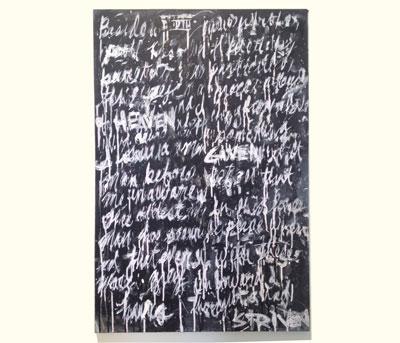Matt Vega at Ille

The paintings of Matt Vega, on view at Ille Arts in Amagansett, mark a bit of a homecoming for the artist, who received an M.F.A. from Yale in photography, but began his studies in painting at Boston University.
Living in Amagansett since 2002, his incorporation of words into his images speaks to a childhood spent in New York City in an era when graffiti still clung to the outside of subway cars. That free-form lettering of the artist’s tags, or obscure street poetry, has been transposed by Mr. Vega into expressive and painterly canvases where the mark becomes text and the words, while meaningful, are given an expressionistic treatment.
They might be full stanza from Wordsworth or fragments of other pieces of poetry. Letters may impart meaning or stand alone as signifiers of themselves. It can be up to the viewer as to how to perceive them. There is enough visual interest in the composition itself to keep from seeking further meaning, but at some point the temptation to read the painting takes hold.
It is not always easy. Individual letters are often obscured by background colors in the same family. The overall rhythm and the sheer scale of the paintings can in some cases cause the viewer to look past the familiar marks and instead appreciate them solely for their composition.
If one is able to read the lines, or between them as it were, there is a trove of material to appreciate. Robert Frost is represented by a sizable poem, “Neither Out Far Nor Deep.” William Wordsworth is there in “Resolution and Independence,” in a painting that loudly and impressionistically proclaims its title.
Other works also touch on the Wordsworth poem, including parts of individual stanzas and, in the case of one painting, “Twenty Stanzas‚” the poem in its entirety. The assumption might be that paintings about language cannot really be about paint, but even in this work the language has a visual quality that the artist quite deliberately evokes. Black and white smear into different registers of gray and the dark letters appear submerged in the drippy white of the surface even as they remain legible. The handwriting of the brush is muscular, capital letters, clear and graphic, while everything around tries to usurp its import but does not succeed.
“My whole life I have lived in pleasant thought, As if life’s business are a summer mood; As if all needful things would come unsought To genial faith, still rich in genial good.” The choice of such elegant words and poetry compels the viewer to read on.
Many paintings are in black and white but Mr. Vega does use color in some of them. The acrylic he places on drop cloths, simply pinned to the walls of the gallery, takes on the quality of oil paint in his tonal blends of color with white and black as foils. The paintings, which are all dated from this year, seem to come from different seasons, but perhaps it is merely the mental state of the artist.
Mr. Vega has an equivalent stake in how viewers read his paintings in comparison to what they see when looking at them. One’s cognitive functions matter just as much in the mix as the aesthetic concerns. Both should be satisfied with this enthralling show, on view through Monday.
